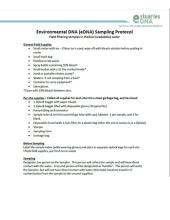
eDNA (environmental DNA) refers to the genetic material found in an environmental sample (water or sediment). eDNA comes from feces, gametes, scales, and cells that an organism sheds, and is easily collected from water and sediment samples. Rapid reductions in analytical costs now allow scientists to analyze eDNA in water samples and identify dozens of species without having to capture live animals or plants.
About these resources
A collaborative research projecting involving the University of New Hampshire and six National Estuarine Research Reserve sites nationwide has developed and pilot tested eDNA sample collection and analysis protocols that are suitable for use in highly variable estuarine conditions. The five PDFs below provide field and lab protocols outlining methods for preparing for field work, collecting water samples, and filtering samples to extract eDNA. The protocols are also available in video format on the eDNA website.
eDNA Water Sampling Protocol - for preparing sampling kits, and collecting, storing and shipping water samples or eDNA analyses
Download Protocol PDF
Video: eDNA Sampling Kit Prep
Video: eDNA Water Sampling Protocol
eDNA Field Filtering Protocol - for field filtering water samples in shallow (wadeable) water
eDNA Lab Filtering Protocol - for filtering aqueous environmental samples in preparation for DNA extraction
Download Protocol PDF
Video: eDNA Water Sample Filtering for eDNA Protocol
PCR Validation Protocol - for design and computer validation for PCR probes, including a general checklist of steps to develop a PCR probe
Manual for Larval Fish eDNA sampling at Wells NERR - for detecting fish species by extracting eDNA from water and captured specimen biomass from a larval tows